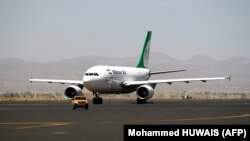Issues relating to the interception of an Iranian airliner by U.S. fighter jets on Thursday June 23 have been playing out in Iran's domestic scene while questions continue to be raised about ambiguities mainly as a result of Iran's secretive behavior.
Meanwhile, officials of Iran's hardliner dominated Judiciary appeared to be exerting pressure on President Hassan Rouhani’s administration to force it into some kind of aggressive diplomacy the administration seems to be reluctant to exercise at the time being.
Prosecutor General Mohammad Jafar Montazeri wrote a letter to Foreign Minister Javad Zarif on Saturday, calling on him to "take action for an international legal prosecution that would teach the Americans a lesson."
Montazeri opined that the U.S. forces' behavior was "in contravention of international law, as well as the Chicago and Montreal Conventions." He further described the U.S. move to intercept the plane as "dangerous and threatening."
Referring to reactions by Mahan Air and the Iranian Civil Aviation Organization, Montazeri called on Zarif to take prompt action to restore the rights of the passengers on board the plane.
The U.S. military issued a statement on July 23 saying, “The professional intercept was conducted in accordance with international standards,” when a Mahan airlines passenger plane was approached by at least one fighter jet for visual identification as it was flying over Syria.
Earlier, both Mahan Air and the Iranian Civil Aviation Organization condemned the interception and said that the plane's passengers and crew were wounded as a result of the pilot's sudden descending manoeuvre.
This comes while Beirut Airport officials have confirmed that no one was seriously harmed during the incident and that al the passengers were well at the time when Mahar Air landed in Beirut.
Meanwhile U.S. military said that the jets observed safe distance from the airliner while inspecting the undeclared flight from Tehran. Iranian observers concluded that the pilot panicked at the sight of the U.S. aircraft and descended without being told to.
In another move initiated from the Judiciary, Ali Baqeri, deputy Judiciary Chief for international affairs, vowed that the Iranian "Judiciary will use all of its domestic and international potential to prove to the United States that the time for hit and run action is over."
Baqeri charged that U.S. forces' behavior "was against international aviation regulations and threatened civilian lives."
However, there are some indications pointing to the fact that the Iranian aircraft was not flying in the predetermined corridor for international flights or it deviated from its route. Meanwhile, the flight number and the airliner's name was not registered according to protocols.
Some Iranian Twitter users confirmed that the "Mahan Air flight was in a totally unidentified corridor and refused to respond to incoming radio messages."
Hardliner journalist Sajjad Abedi challenged this assertion and charged that U.S. jets that took off from Jordan were setting the scene to mislead Syrian AA batteries to shoot down the Iranian aircraft.
Iranian Majles Speaker Mohammad Baqer Qalibaf, who is a commercial jet pilot, also repeated the accusation on his Twitter page and said the pilot had received TCAS (Traffic Collision Avoidance System) warnings twice. But this in itself could be a sign that something was not quite normal with the flight path.
Other users ruled out the hypothesis. Reports from Iran on Saturday morning said the Mahan Air pilot and some others on board the aircraft were questioned and or debriefed by officials upon returning to Tehran.
This might reinforce the statement apparently backed by Syrian and Jordanian aviation officials about the Iranian plane going astray before it was intercepted.
In the meantime, several Twitter users have said that the presence of two men on board the plane who were previously seen on the state TV denying a major explosion West of Tehran has stirred further controversy about the case.
On June 26 there was a mysterious explosion near a military complex west of Tehran, which government-controlled media was quick to dismiss as an accident. To prove state-controlled media showed a video a few hours later showing two men at a barbeque stand where a reporter was asking a man if he had heard any explosion. The man claiming to be from the area of the explosion denied any serious incident.
Now, several well-known Twitter users say that the same men were on the Mahan flight, raising suspicions of a set up.
Did Iran send an undeclared flight to Beirut, which elicited an alarm and led the U.S. to react? After all, the plane landed in Beirut, but since May Mahan had suspended flights to Lebanon probably because of coronavirus restrictions.






